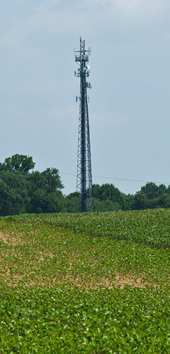Transmission Facilities Coordination Group
Purposes of the Tower Coordination Process

1. To establish a reliable and expedient process for telecommunication carriers to site transmission facilities in the county and to speed deployment of services for residents while maintaining adequate public protection.
Action: Montgomery County amended its zoning ordinance to allow "by right" sites in most zones, to encourage co-location and to establish reasonable height and setback requirements:
"By right" placement of antennas on existing private and public buildings and structures in all zones, except attachment to a single family residence;
"By right" placement of new monopoles in industrial, commercial and some agricultural zones; special exception process retained for new sites in single family residential zones;
Effect: Greatly reduced application review time when compared to the lengthy and costly special exception hearing process that had been required for all sites in the past.
2. To promote appropriate location and co-location of transmission facilities to minimize adverse impact to the community and public facilities. To provide a forum for private carriers and public agencies to meet and reach consensus on sensible siting of transmission facilities. To encourage public agencies to develop and adopt criteria and a process to expedite requests for use of public land for telecommunication purposes.
Action: Creation of a Tower Committee composed of representatives from relevant land owning and land use agencies to review all new telecommunications facilities and antenna siting requests. The Committee meets frequently, with industry reps in attendance and actively participating, to review and make recommendations on all applications. Meetings are open to the public.
3. To provide a centralized source for private providers, County agencies, and the public to obtain information regarding the County's siting process and the location and description of potential sites
Action: Appointment of a Tower Coordinator and creation of an electronic database that contains information about all antenna and tower sites, all public sites, all buildings of certain heights, all public property, and other data helpful to providers and the public. Providers file annual plans with the Tower Coordinator which tell their site plans for the next 18 months to two years.
Results: Invaluable tool for providers, agencies and the public in evaluating co-location possibilities and for alternate sites which may have less negative impact on the community.
